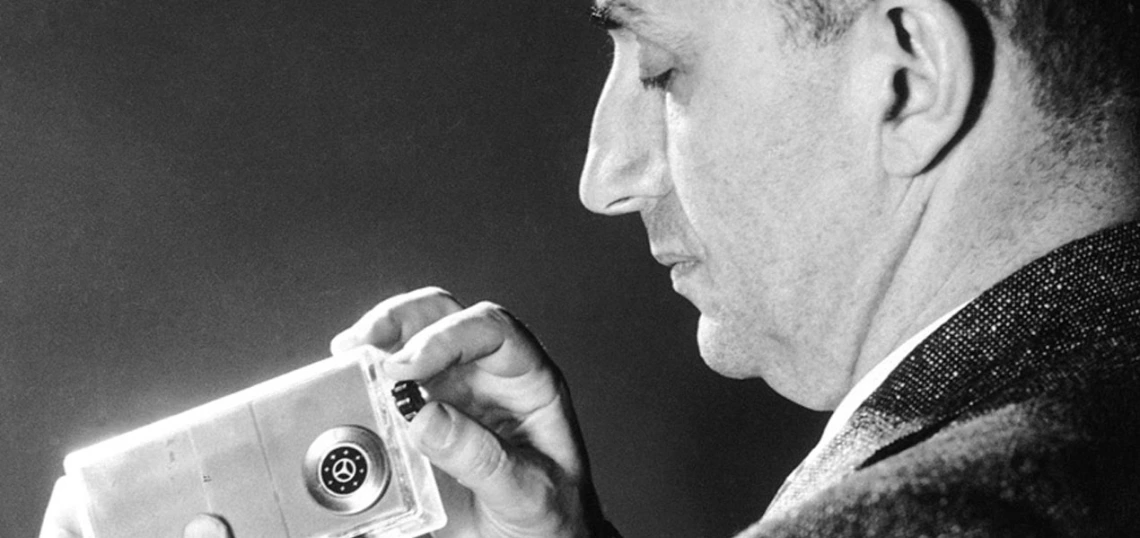Keonjian Distinguished Professorship Honors Life and Work of 'Father of Microelectronics'
Professor Wolfgang Fink is the first recipient of the Edward and Maria Keonjian distinguished professorship in microelectronics.

Edward Keonjian holds a solar-powered radio that runs continuously in daylight and for 500 hours in darkness. Keonjian and fellow GE engineer James O'Hearn built the device in 1955. (Photo: AP)
Edward Keonjian, the “father of microelectronics,” would have been 100 years old on Aug. 14, 2009.
To mark his centennial, the College of Engineering has announced the establishment of the Edward and Maria Keonjian Distinguished Professorship in Microelectronics, the result of a million-dollar endowment by Keonjian and his wife Maria. The first holder of this distinguished professorship will be Wolfgang Fink, who will move to UA from the California Institute of Technology and NASA’s Jet Propulsion Laboratory.
During his life, Keonjian had more than 100 publications and 27 U.S. and foreign patents. He edited and co-authored Microelectronics: Theory, Design, and Fabrication, which was published in 1963; it sold more than a million copies and was translated into six languages.
Keonjian was a pioneer of low-power electronics, and in 1954 designed the world's first solar-powered, pocket-sized radio transmitter, which is now at the Smithsonian National Museum of American History. He organized the first international symposium on low-power electronics in 1963.
Keonjian began his work in microelectronics at GE in 1951, and went on to work for Grumman Aircraft, where he supervised 165 staff and worked with Neil Armstrong as chief of failure analysis on the Apollo 11 project. He worked for several years in India and Egypt as an electronics specialist for the United Nations, and spent 12 years as a U.S. member of NATO’s Advisory Group for Aerospace Research and Development.
He was a fellow of the Institute of Electrical and Electronics Engineers, won the Distinguished Colleague Award from the Aerospace Industries Association, and was a member of the New York Academy of Science.
Edward Keonjian was born in 1909 in what is today known as the republic of Georgia. He obtained his doctorate in electrical engineering from the Leningrad Institute of Electrical Engineering in 1932.
During the siege of Leningrad, now St. Petersburg, Russia, in World War II, Keonjian was teaching at the institute. Millions were dying from cold and starvation, and after he too collapsed from hunger, he was mistaken for dead and placed in a common grave. He was rescued after a passerby saw his hand sticking out of this grave and noticed a slight movement.
Keonjian was evacuated from Leningrad, only to be captured by the Germans and sent to a slave labor camp. His duties at the camp included dismantling aircraft for spare parts. He was liberated after World War II and emigrated to the United States with his first wife, Virginia, who died in 1969.
He arrived in 1947 with no friends, relatives, or money, and unable to speak English. So he pumped gas, worked in a furniture store, and learned English. He later rose to become an outstanding scientist and inventor in microelectronics.
Keonjian was an enthusiastic traveler and a member of the Explorers Club, the Circumnavigators Club, and the Archaeological Institute of America. He moved to Green Valley, Ariz., in 1993 from Great Neck, N.Y. In 1997 he chronicled his life story in his autobiography, Survived to Tell. He died in 1999.
Wolfgang Fink
Professor Wolfgang Fink, the first recipient of the Edward and Maria Keonjian distinguished professorship in Microelectronics, is a senior researcher at NASA’s Jet Propulsion Laboratory, and the founder and director of the Visual and Autonomous Exploration Systems Research Laboratory at the California Institute of Technology, or Caltech, where he is a visiting associate in physics in the division of physics, mathematics and astronomy. He also holds concurrent appointments as visiting research associate professor of ophthalmology and neurological surgery at the University of Southern California.
Fink’s interest in human-machine interfaces, autonomous/reasoning systems, and evolutionary optimization has focused his research programs on biomimetic (implantable) systems, biomedical sensor development, autonomous robotics, cognitive/reasoning system, artificial vision, computer-optimized design, and autonomous space exploration.
Fink graduated summa cum laude in 1997 with a doctoral degree in theoretical physics from the Institute for Theoretical Physics at the Eberhard-Karls-University in Tübingen, Germany. He got bachelor’s and master’s degrees in physics, in 1990 and 1993, respectively, from the Georg-August-University in Göttingen, Germany.
He is a member of the German Physical Society, the Association for Research in Vision and Ophthalmology, and the American Association for the Advancement of Science.
“I am very enthusiastic about joining the University of Arizona with its multitude of research, collaborative, and educational opportunities to pursue and expand my various research interests,” Fink said. “Moreover, I am extremely honored to be the first recipient of the Edward and Maria Keonjian distinguished professorship.”
He began his appointment officially on Oct. 5, 2009, and joined the faculty of the department of electrical and computer engineering, where he intends to relocate and further expand his Visual and Autonomous Exploration Systems Research Laboratory to conduct research in the areas of human-machine interfaces, autonomous/reasoning systems, and evolutionary optimization. He is also on the faculty of the department of biomedical engineering. He plans on moving to Tucson by the end of this year.

